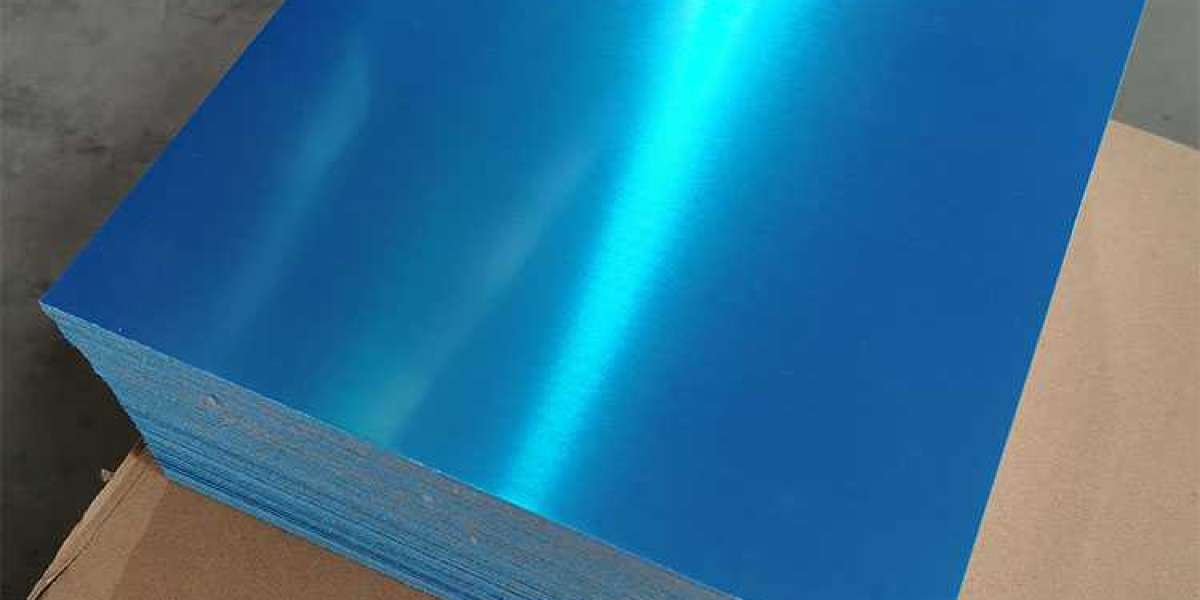Introduction to Aluminum 3003 H14
Aluminum 3003 H14 is a popular alloy known for its excellent corrosion resistance, high formability, and moderate strength. This particular grade, categorized under the 3000 series of aluminum alloys, is often used in applications where superior performance and versatility are required. The "H14" temper indicates that the alloy has been strain-hardened to a specific strength, making it ideal for many manufacturing and industrial uses.
What is Aluminum 3003 H14?
Aluminum 3003 H14 is a non-heat-treatable alloy that contains manganese as its primary alloying element. It belongs to the 3000 series of aluminum alloys, which are known for their moderate strength and outstanding resistance to corrosion. The H14 temper refers to an intermediate level of strength achieved through strain-hardening, making it a good option for products requiring a balance between formability and durability.
A Quick Overview of Its Alloys and Grades
Aluminum alloys are typically categorized by series numbers, with the 3000 series representing a range of alloys containing manganese as the primary alloying element. The grades within this series vary based on strength, formability, and the specific temper designation, which refers to the level of hardness or treatment applied. The H14 temper, in particular, strikes a balance between flexibility and strength, making it suitable for a wide array of applications.
Composition of Aluminum 3003 H14
Key Alloying Elements in 3003 H14
The primary alloying element in Aluminum 3003 H14 is manganese, which contributes to its strength and corrosion resistance. The addition of manganese makes the alloy non-heat treatable, meaning it cannot be hardened through heat treatment but can be strengthened through cold working. Other elements found in small amounts in 3003 include silicon, iron, and copper, which enhance various mechanical and physical properties.
Role of Manganese in Aluminum 3003 H14
Manganese plays a crucial role in the properties of Aluminum 3003 H14. It enhances strength and durability without compromising the material’s formability. The presence of manganese helps prevent corrosion and improves the overall performance of the alloy, especially in environments that expose the material to moisture or harsh conditions.
Mechanical Properties of Aluminum 3003 H14
Strength and Hardness Characteristics
Aluminum 3003 H14 offers a moderate level of strength, which makes it suitable for a variety of applications where high strength is not the primary requirement. The alloy exhibits excellent formability, making it ideal for use in products that need to be bent or shaped during manufacturing. Its hardness is sufficient for most non-structural applications, although it is softer than alloys such as 5052 or 6061.
Yield Strength, Tensile Strength, and Elongation
The yield strength of Aluminum 3003 H14 typically ranges around 35 MPa, while its tensile strength can be up to 140 MPa. These values indicate that the material can withstand moderate stresses before deforming. In terms of elongation, the alloy can stretch up to 20-25%, which means it is highly ductile and can be easily formed into complex shapes.
Physical Properties of Aluminum 3003 H14
Density, Melting Point, and Thermal Conductivity
The density of Aluminum 3003 H14 is approximately 2.73 g/cm³, which is typical for aluminum alloys. This low density makes it a lightweight material ideal for applications where weight is a critical factor, such as in transportation. The melting point of 3003 is around 660°C (1220°F), and its thermal conductivity is high, making it useful in heat exchange systems.
Electrical Conductivity and Corrosion Resistance
While Aluminum 3003 H14 has moderate electrical conductivity, it is its corrosion resistance that stands out. The alloy forms a natural oxide layer on its surface, which protects it from further corrosion in most environments, including marine and industrial settings. This property makes it a reliable choice for applications exposed to moisture, air, or chemicals.
Aluminum 3003 H14 vs. Other Aluminum Alloys
Comparison with Aluminum 1100 and 5052
When compared to Aluminum 1100, which is another popular alloy in the 1000 series, Aluminum 3003 H14 has slightly higher strength but is still more malleable than many other alloys. In comparison to 5052, a stronger and more corrosion-resistant alloy, 3003 H14 is less robust but more cost-effective, making it ideal for less demanding applications where strength is not the top priority.
Advantages and Limitations Compared to Other Alloys
The advantage of 3003 H14 lies in its excellent formability and corrosion resistance, especially in industrial and architectural applications. However, its lower strength and moderate fatigue resistance can be limitations when used in structural or high-stress environments.
How Aluminum 3003 H14 is Processed
The Role of Cold Working in the H14 Temper
The H14 temper of Aluminum 3003 is achieved through cold working or strain-hardening, a process that increases the material’s strength without changing its chemical composition. This treatment involves deforming the metal at room temperature, which dislocates the metal’s crystal structure, increasing its resistance to further deformation.
Heat Treatment and Annealing Process
Although Aluminum 3003 cannot be heat-treated to enhance its strength, it can be annealed to soften the material and increase its workability. The annealing process involves heating the aluminum to a specific temperature and then allowing it to cool slowly, which helps reduce internal stresses and increases ductility.
Aluminum 3003 H14: Surface Finish and Coatings
Anodizing Aluminum 3003 H14
Anodizing is a common surface treatment used for aluminum alloys, including 3003 H14. The process involves electro
lytic treatment, which creates a durable and protective oxide layer on the surface of the aluminum. This layer not only enhances the alloy's corrosion resistance but also provides an aesthetic finish that can be dyed in various colors. Anodizing aluminum 3003 H14 improves its resistance to wear and tear, making it a great option for architectural applications and products exposed to harsh environments.
Common Surface Treatments for Durability
In addition to anodizing, Aluminum 3003 H14 can be treated with other coatings, such as paint or powder coating, to enhance its durability and appearance. These treatments provide an additional layer of protection, helping the material withstand environmental stresses, chemicals, and physical abrasion. Powder coating, in particular, provides a tough, weather-resistant finish that is often used in exterior applications, such as siding or architectural facades.
Applications of Aluminum 3003 H14
Industrial and Commercial Uses
Aluminum 3003 H14 is widely used across various industries due to its combination of strength, formability, and corrosion resistance. It is commonly found in industrial equipment, sheet metal products, signs, and lightweight structural components. Its ability to be easily fabricated into sheets, coils, or plates makes it ideal for custom manufacturing and quick production processes.
Popular Applications in the Construction and Automotive Industries
In the construction industry, aluminum 3003 H14 is used for roofing, siding, and cladding, where its corrosion resistance and lightweight properties are highly valued. It is also found in building facades, where its ability to withstand the elements makes it an excellent material for long-lasting structures. In the automotive industry, 3003 H14 is used for vehicle body panels and components, as it offers a balance between weight reduction and durability, enhancing fuel efficiency without sacrificing strength.
Advantages of Using Aluminum 3003 H14
Excellent Formability and Workability
One of the standout advantages of Aluminum 3003 H14 is its formability. The alloy is highly malleable, allowing it to be easily shaped into complex forms without cracking or breaking. This makes it ideal for applications where parts need to be bent, stamped, or deep-drawn, such as in the production of automotive panels, appliance components, and architectural elements.
Corrosion Resistance and Durability in Harsh Environments
Aluminum 3003 H14 is naturally resistant to corrosion due to the formation of an oxide layer on its surface. This layer protects the metal from moisture, air, and chemicals, making it ideal for use in marine environments, chemical processing, and food industries where exposure to water or corrosive elements is frequent. Its durability in harsh conditions extends its usefulness in both indoor and outdoor applications.
Limitations of Aluminum 3003 H14
Lower Strength Compared to Other Alloys
While Aluminum 3003 H14 offers good strength for many applications, it is not as strong as other aluminum alloys, such as 5052 or 6061. Its yield strength is relatively low, meaning it may not be suitable for applications requiring high structural integrity or those subjected to significant mechanical stress. Therefore, it is typically used in non-structural applications, where strength is not the most critical factor.
Challenges in High-Stress Applications
Due to its lower strength, Aluminum 3003 H14 is not ideal for use in high-stress environments where heavy loads or pressure could cause the material to deform. Applications requiring high fatigue resistance or impact strength may require the use of a stronger aluminum alloy or an alternative material that can withstand more demanding conditions.
Aluminum 3003 H14 in the Food and Packaging Industry
Use in Food Containers and Packaging
Aluminum 3003 H14 is widely used in the food industry for applications such as food containers, trays, and foil wraps. Its excellent corrosion resistance and ability to form a protective oxide layer make it a perfect material for food packaging, helping preserve freshness and preventing contamination. The alloy is also lightweight, which aids in transportation and storage.
Benefits for Food Safety and Hygiene
The non-porous nature of Aluminum 3003 H14 ensures that food products are protected from environmental contaminants. Furthermore, the alloy’s ability to maintain an airtight seal prevents spoilage and helps extend shelf life. As a food-safe material, it is widely used in packaging for ready-to-eat meals, snack foods, and frozen products.
Impact of Aluminum 3003 H14 on the Automotive Industry
Weight Reduction and Fuel Efficiency
In the automotive industry, Aluminum 3003 H14 is utilized to reduce vehicle weight, improving fuel efficiency and performance. The alloy’s lightweight properties are essential for manufacturers seeking to meet fuel economy standards and reduce the environmental impact of transportation. Its ability to be shaped into complex forms allows for innovative design solutions that optimize vehicle structure while keeping weight to a minimum.
Applications in Vehicle Body Parts and Components
3003 H14 is commonly used for vehicle body panels, exterior trim, and interior components. The alloy is lightweight yet durable enough to withstand the rigors of driving, making it suitable for parts like bumpers, side panels, and grills. Its excellent corrosion resistance ensures that these parts maintain their appearance and integrity over time, even under exposure to the elements.
The Role of Aluminum 3003 H14 in the Construction Industry
Roofing, Siding, and Cladding Applications
In the construction industry, Aluminum 3003 H14 is valued for its durability and aesthetic appeal. The alloy is used for roofing, siding, and cladding, offering a low-maintenance, long-lasting solution for buildings. Its corrosion resistance makes it ideal for structures in coastal areas, humid climates, or locations with high industrial activity, where other materials may deteriorate more quickly.
Advantages in Building Materials for Energy Efficiency
In addition to its physical properties, Aluminum 3003 H14 contributes to energy efficiency in buildings. Its reflective surface can help reduce solar heat gain and improve thermal insulation, making it an excellent choice for energy-efficient building designs. The alloy’s lightweight nature also simplifies installation, reducing labor and transportation costs.
Corrosion Resistance of Aluminum 3003 H14
How Aluminum 3003 Resists Corrosion
Aluminum 3003 H14 naturally forms a protective oxide layer when exposed to air, which prevents corrosion from penetrating the material. This oxide layer is particularly effective in protecting the alloy from moisture, salts, and chemicals, making it a preferred choice in industries where corrosion is a major concern. The alloy’s self-healing properties further enhance its durability.
Environmental Factors Affecting Corrosion Resistance
While Aluminum 3003 H14 is highly resistant to corrosion, extreme environmental conditions, such as high levels of chlorides, acidic or alkaline environments, or high temperatures, can weaken its protective layer. Therefore, it is essential to choose the right surface treatments and maintenance practices to ensure the material’s longevity in challenging environments.
Welding and Joining Aluminum 3003 H14
Techniques for Welding 3003 H14
Aluminum 3003 H14 is commonly welded using processes like TIG welding, MIG welding, and stick welding. However, due to its relatively low strength, care must be taken to avoid over-heating the material during the welding process. Proper welding procedures ensure that the joint maintains strength and corrosion resistance, critical for structural applications.
Advantages and Challenges in Joining
Welding Aluminum 3003 H14 presents challenges due to its susceptibility to distortion when exposed to heat. However, it offers good weldability compared to other aluminum alloys, and its high ductility allows for easier joining. Careful attention to welding parameters and preheat techniques can help achieve strong, durable joints.
Recycling and Sustainability of Aluminum 3003 H14
Aluminum's Recyclability and Environmental Benefits
Aluminum, including 3003 H14, is highly recyclable. The recycling process requires only a fraction of the energy needed to produce new aluminum, making it an environmentally friendly material. Aluminum's infinite recyclability ensures that it can be reused without degradation of quality, supporting sustainable manufacturing practices.
The Role of 3003 H14 in Sustainable Manufacturing
By using recycled aluminum 3003 H14, manufacturers can reduce their carbon footprint and contribute to sustainable production practices. Aluminum’s recyclability ensures that products made from this alloy can be reused multiple times, promoting the circular economy and reducing reliance on raw material extraction.
Cost of Aluminum 3003 H14
Factors Influencing the Price of Aluminum 3003
The price of Aluminum 3003 H14 is influenced by various factors, including raw material costs, manufacturing processes, and market demand. While 3003 H14 is generally more affordable than higher-strength alloys like 5052, its cost can fluctuate based on the price of aluminum and global supply chain factors.
Comparison with Other Materials
Compared
to other materials such as steel or titanium, Aluminum 3003 H14 tends to be more cost-effective, especially when considering its lightweight nature and ease of fabrication. While it is not as strong as some of its counterparts, its affordability, formability, and corrosion resistance make it a preferred choice for many applications where strength requirements are moderate, and cost control is essential.
Choosing the Right Aluminum Alloy for Your Project
When to Choose 3003 H14 Over Other Alloys
Selecting the right aluminum alloy depends on the specific requirements of the project, including strength, corrosion resistance, and formability. Aluminum 3003 H14 is ideal for applications where moderate strength and high formability are needed, but where extreme mechanical strength is not a priority. It is a versatile alloy suitable for many commercial, architectural, and industrial uses.
Key Considerations in Material Selection
When choosing an alloy, consider factors such as the environment in which the material will be used, its exposure to chemicals or moisture, the required strength and fatigue resistance, and processing capabilities. Aluminum 3003 H14 is a great choice for projects where ease of fabrication and corrosion resistance outweigh the need for higher strength.
Conclusion
Aluminum 3003 H14 is a highly versatile and reliable alloy that finds widespread use across multiple industries due to its moderate strength, excellent corrosion resistance, and formability. From construction and automotive applications to food packaging and electrical components, its range of benefits makes it an indispensable material in both industrial and commercial settings. While it may not be the strongest aluminum alloy available, its balance of properties and cost-effectiveness ensures that it remains a popular choice for applications where durability, weight reduction, and ease of fabrication are paramount.
The future of Aluminum 3003 H14 looks bright, especially with its role in sustainable manufacturing practices. As demand for recyclable and energy-efficient materials grows, Aluminum 3003 H14 will continue to play a significant role in shaping a greener, more efficient future across various sectors.








